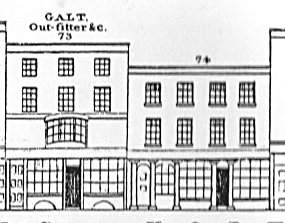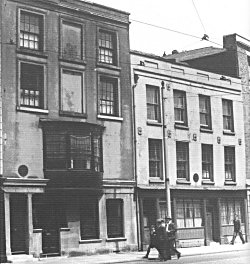
Nos. 73 - 74 High Street

After examining the previous few buildings for which there is relatively little research material available it comes as some relief to arrive at two buildings which have been photographed and drawn repeatedly down the years. The reason for this is quite simply that both buildings are associated with renowned men of Portsmouth. No. 73 was the birthplace of the author George Meredith and No. 74 was sometime the home of Admiral Anson.
George Meredith was born at No. 73 on 12th February 1828. His father Augustus Meredith was a tailor but probably not much of a businessman since in 1837 he was forced to declare himself bankrupt whereupon he moved to London to seek work. George was sent to live with relatives in the country and never lived in Portsmouth again, indeed he frequently denied having any connection to the town. Thus, by the time that Charpentier had commissioned his Strangers Guide, the Meredith family were no longer in town and by 1860 would hardly have been remembered. It is only the fact that Meredith later achieved fame as a writer that No. 73 became a landmark in Portsmouth. Sadly his residence in the house informs our research not at all.

If Meredith's connection to No. 73 is tenuous then Anson's to No. 74 is slender indeed. As he died in 1762 his presence there could have no more than a peripheral influence on our research, indeed it is even possible that the house he occupied was not the same building that we see in Charpentier and later photographs. This is difficult to ascertain as none of the acknowledged biographies of Anson mention that he lived in Portsmouth, though his connections with the town are well documented. A drawing of the house from around 1890 by Snape has a caption which infers that Anson only lodged at this house, which would have been common practice amongst naval officers, and it followed that he would not have owned the property. This would suggest that there is unlikely to be any documentary evidence to confirm Anson's presence especially given that the practise of numbering houses did not originate until the 1830s so even a verbal record would be open to misinterpretation. If Portsmouth were to claim as it's own every naval officer who had lodged in town then the list would be very lengthy and it wouldn't necessarily begin with Lord Nelson.
Passing over the relevance of Meredith and Anson to our researches we note that the basic structures of both houses remained virtually the same in all known representations of them, though none, apart from Charpentier, are from earlier than the late 19th Century. Since the upper floors shown in these images are identical to those portrayed by Charpentier (apart from the middle windows on the second and third floors of No. 73 being bricked up) we can be confident that they show the buildings as they were in 1860. The differences, though relatively minor, are in the configuration of the ground floor facades.
Documentary Evidence
The 1861 Census, Sch. 64, lists William Bubb (31, Carpenter and Chinaman, employing 3 men and 2 boys) in residence with his wife Maria (29) and a servant, Eliza North (13).
Schedule 65 includes Samuel E. Soloman (46, General Dealer from Devonport), his wife Julia (31) and 4 minors, undefined but assumed to be their children - Celia (9), Moses (6), Frances (4) and Rosette (no age given). There is a subsequent section in the census labelled Schedule 65A and this records Thomas Buckworth (36, Ship's Smith from Lancaster) and his wife Mary (38).
We can be confident that these entries refer to the families living at Nos. 73 and 74 as Kelly's Directory of 1859 lists the occupant of No. 73 as William Bubb, a builder and in a separate section records him as a dealer in China, Glass and Earthenware. Also the Post Office Directory of the same year lists Samuel Soloman as a Dealer in Curiousities at No. 74.
Simpson's 1863 directory lists neither property but Harrod's 1865 Directory lists Joseph Bailey, Boot and Shoe Manufacturer at No. 74. Hunt's Directory of 1852 shows that William Bubb was operating out of premises in Penny Street whilst Samuel Soloman was in Pembroke Street.
Summary
The ground floor of No. 73 appears to have been converted from the shop that we see in Charpentier, to a residential property at some point between 1842 and the end of the century. The alterations created a frontage of some moderate distinction, displaying as it did, a profusion of stained glass in the windows. It could be argued that the presence of the Bubb family during the early 1860s makes it unlikely that the house would have been gentrified at that time, but this places too much faith in a modern interpretation of the trade of "Builder" and discounts the more refined secondary business of dealer in china. The 1861 OS map shows what may be a complex of out-buildings to the rear of No. 73 and these may well have been accessible from White Hart Road thereby enabling Bubb to separate business and family quite effectively. It is also possible that he retained the premises in Penny Street for his business and occupied No. 73 solely as a place of residence. The absence of any images from the latter half of the 19C make it impossible to determine when the conversion occurred but for the sake of the model it will be assumed that it happened before 1860.
In contrast, No. 74 seems to have taken a distinct turn down market. In Anson's day the property must have been fit for an Admiral and the proportions of the upper floors tend to confirm that this building was probably of Georgian origin. The ground floor however has seen the attention of a rather shoddy builder who erected a facade quite out of keeping with the rest of the building. The original lines have been totally obscured though, curiously, there appears to be one remnant from the original structure. In the space between the second and third columns there is an ornate round-headed window which could easily have graced a house of the 1750s. Again, the absence of evidence for a date the changes may have happened leave us free to conjecture that it was pre-1860 and so the model will show the building as the later photographs show it to have been.